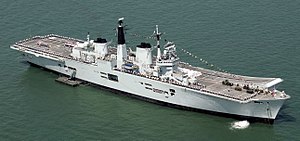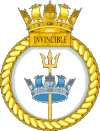 HMS Invincible in 2005
| |
| History | |
|---|---|
| Name | Invincible |
| Ordered | 17 April 1973 |
| Builder | Vickers Shipbuilding Limited, Barrow-in-Furness, England |
| Laid down | July 1973 |
| Launched | 3 May 1977 |
| Sponsored by | Queen Elizabeth II |
| Commissioned | 11 July 1980 |
| Decommissioned | 3 August 2005 |
| Stricken | 10 September 2010 |
| Homeport | HMNB Portsmouth |
| Identification |
|
| Nickname(s) | "Vince"[1] |
| Fate | Scrapped 2011[2] |
| Badge |  |
| General characteristics | |
| Class and type | Invincible-class aircraft carrier |
| Displacement | |
| Length | 689 ft (210 m) |
| Beam | 118.1 ft (36.0 m) |
| Draught | 28.9 ft (8.8 m) |
| Propulsion |
|
| Speed | 28 knots (52 km/h; 32 mph) max |
| Range | 7,000 nmi (13,000 km; 8,100 mi) at 18 knots (33 km/h; 21 mph) |
| Complement | 1,051 total, including 726 ship's company and 384 Air Group personnel |
| Armament |
|
| Aircraft carried |
|
HMS Invincible was the Royal Navy's lead ship of her class of three light aircraft carriers. She was launched on 3 May 1977 as the seventh ship to carry the name. She was originally designated as an anti-submarine warfare carrier, but was used as an aircraft carrier during the Falklands War, when she was deployed with HMS Hermes. She took over as flagship of the British fleet when Hermes was sold to India. Invincible was also deployed in the Yugoslav Wars and the Iraq War. During the Falklands Conflict, Argentinian media reported Invincible as sunk on several occasions. In 2005, she was decommissioned, and was eventually sold for scrap in February 2011.[5]
- ^ "Sea Harriers still in business". Navy News. Archived from the original on 8 September 2008. Retrieved 1 July 2008.
- ^ Cite error: The named reference
salewas invoked but never defined (see the help page). - ^ "Invincible Recycling Report" (PDF). DE&S. Retrieved 29 January 2013.
- ^ The Big Interview: Admiral Sir Alan West
- ^ "HMS Invincible sold for scrap to Turkish ship recyclers". BBC News. 2 August 2011. Retrieved 2 August 2011.